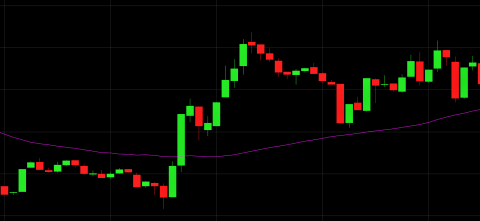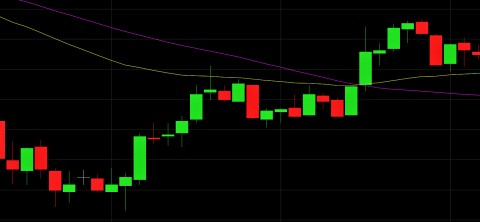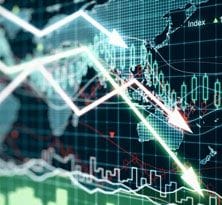What is the simple moving average?
The simple moving average (SMA) is a popular technical analysis tool. Used mainly to identify trends, it is one of the most commonly used indicators across all financial markets. The SMA works by smoothing out past price data.
It shows the average price of a security over a certain length of time and is plotted as a single line on a chart. Because it is customisable over different time horizons, the SMA is used by both short-term traders and long-term investors.
For example, a short-term trader may use the 20-day simple moving average to identify short-term price trends. In contrast, a long-term investor may use the 200-day SMA to identify the long-term trend. It can be applied to stocks, currencies, indices, exchange-traded funds (ETFs) and many other investments.
The simple moving average is a lagging indicator because it is based on past prices. The longer the time period of the SMA, the greater the lag. While the SMA is a helpful technical analysis tool, it is best used along with other popular indicators such as trend lines, volume and Bollinger Bands®.
How to calculate the SMA
The simple moving average is quite easy to calculate.
- It is calculated by averaging a number of past data points. Past closing prices are most often used as data points.
- For example, to calculate a security’s 20-day SMA, the closing prices of the past 20 days would be added up, and then divided by 20.
- Similarly, to calculate a security’s 200-day SMA, the closing prices of the past 200 days would be totalled, and divided by 200.
Most trading platforms offer tools which can automatically calculate the SMA. This means that traders will almost never have to manually calculate the SMA for their trades. Modern charting software will perform all the calculations instantly.

How to trade with a simple moving average
There are two main ways to use the simple moving average. The first is trend analysis. At a very basic level, traders and investors use the SMA to assess market sentiment and get an idea of whether the price of a security is trending up or down.
The basic rule for trading with the SMA is that a security trading above its SMA is in an uptrend, while a security trading below its SMA is in a downtrend. For example, a security trading above its 20-day SMA is thought to be in a short-term uptrend. In contrast, a security trading below its 20-day SMA is thought to be in a long-term downtrend. By analysing the SMA, the investor or trader can quickly assess market trends and determine whether the security is trending upward or downward.
Simple moving averages can be useful in spotting trend changes. They can also be used to identify support and resistance levels. Often, during a trend, the SMA will provide a dynamic level of support or resistance. For example, a security in a long-term uptrend may continually pull back a little, but find support at the 200-day SMA. This can also be helpful in identifying trend changes. This method can be used across many markets, including the foreign exchange, indices and stock markets.
Technical and fundamental analysis
One advantage of the simple moving average is that the tool can be used for both technical and fundamental analysis. Technical analysis is mainly used by short-term traders such as day traders. This form of analysis uses past security price patterns to predict future price movements; however, please note that past performance is not a reliable indicator of future results. In contrast, fundamental analysis is favoured by long-term investors. This style of analysis focuses on factors such as company revenue, profit and growth to identify potential investments.
While the two styles are very different, the simple moving average can be used to complement both. For example, a short-term trader that trades using technical analysis may be interested in finding out whether a security is trending up or down over a 10-day period. This trader could analyse the 10-day SMA to determine the trend.
In contrast, a long-term investor that generally uses fundamental analysis might be more interested in buying an upward-trending security after a pullback to the 200-day SMA. This investor could use the SMA to find out how to calculate an attractive entry point.
What is the difference between the simple moving average (SMA) and the exponential moving average (EMA)?
The simple moving average is the simplest type of moving average indicator. It is calculated by adding up past data points and then dividing by the total number of data points. While the SMA is a very popular tool, it does have one main weakness. Some traders and investors believe that it is flawed because every data point has the same weight. They argue that recent data is more important than old data and should therefore have a higher weight. As a result, some traders and investors prefer to use another form of moving average, known as the exponential moving average (EMA).
In comparison to the SMA, the exponential moving average gives more weight to the most recent prices. This is the key difference between the SMA and EMA. The EMA is more responsive to the latest data than the SMA, because the latest data has a larger impact on the calculation. Calculating the EMA is more complicated than the SMA. However, like the SMA, most charting software available will draw an EMA line at the click of a button.

Simple moving average strategies
There are many different trend-based strategies involving the simple moving average. Two of the most popular signals that traders look for are bullish crossovers and bearish crossovers.
A bullish crossover occurs when a security’s price moves back above the SMA after being below it. This action signals that the downtrend or correction is over and a possible uptrend is starting. A bullish crossover can be used as a signal to enter a long trade.
During trending markets, this signal can be quite reliable. However, during choppy or sideways markets, the indicator can be less reliable in measuring market fluctuations. Bullish crossovers are less important when the long-term trend is down.
A bearish crossover occurs when a security’s price falls below the SMA after trading above it. This action signals that the uptrend is over and the trend may now be downward. A bearish crossover can be used as a signal to exit a long position or, alternatively, enter a short position. During choppy or sideways markets, a bearish crossover is less meaningful.
Another popular strategy with the SMA is the moving-average crossover. This occurs when a short-term SMA crosses over a long-term SMA. A moving average crossover is often referred to as a golden cross or death cross.
A golden cross occurs when a security’s short-term SMA crosses above its long-term SMA. For example, the classic setup here is when the 50-day SMA crosses above the 200-day SMA. This is a bullish signal and indicates that the price of the security may continue rising. A golden cross can be used as a signal to enter a long trade.
The reverse of the golden cross is a bearish indicator known as the death cross. A death cross is identified when a security’s short-term SMA crosses below its long-term SMA. For example, the 50-day SMA might cross over and fall under the 200-day SMA. This is a bearish signal and indicates that the price of the security may continue falling. A death cross may be used as an exit strategy.
Summary
The simple moving average is a popular tool that can benefit both short-term traders and long-term investors.
The SMA smooths out price data by averaging a security’s price over a certain length of time. It is drawn as a single line on a chart and is helpful in identifying trends. The benefit of the SMA is that it quickly enables a trader or investor to determine whether a security is trending up or down.
There are a variety of different trading strategies that use the simple moving average. A bullish crossover occurs when a security’s price crosses from below the SMA to above the SMA. This is a positive signal and indicates that the trend may now be upwards. A bearish crossover occurs when a security’s price falls below the SMA from above it. This is a negative signal and indicates that the trend may now be downwards.
A golden cross occurs when a security’s short-term SMA crosses above its long-term SMA. This is a bullish signal and indicates that the trend may now be up. A death cross occurs when a security’s short-term SMA crosses below its long-term SMA. This is a bearish signal and indicates that the trend may now be down.
Simple moving averages can also be used to identify levels of support and resistance. The main drawback of the SMA is that it places an equal weight on each past data point. As a result, some traders prefer to use the exponential moving average. This indicator gives more weight to the most recent data points.
While the SMA is a useful indicator, it should not be used alone. Trades should not be based solely on the simple moving average as a tool. The SMA is best used as part of a comprehensive trading strategy. It can be combined with other technical analysis tools such as trend lines, volume and Bollinger Bands to help traders and investors profit from financial markets.
Disclaimer
CMC Markets is an execution-only service provider. The material (whether or not it states any opinions) is for general information purposes only, and does not take into account your personal circumstances or objectives. Nothing in this material is (or should be considered to be) financial, investment or other advice on which reliance should be placed. No opinion given in the material constitutes a recommendation by CMC Markets or the author that any particular investment, security, transaction or investment strategy is suitable for any specific person.
CMC Markets does not endorse or offer opinion on the trading strategies used by the author. Their trading strategies do not guarantee any return and CMC Markets shall not be held responsible for any loss that you may incur, either directly or indirectly, arising from any investment based on any information contained herein.

Experience our powerful online platform with pattern recognition scanner, price alerts and module linking.
- Fill in our short form and start trading
- Explore our intuitive trading platform
- Trade the markets risk-free